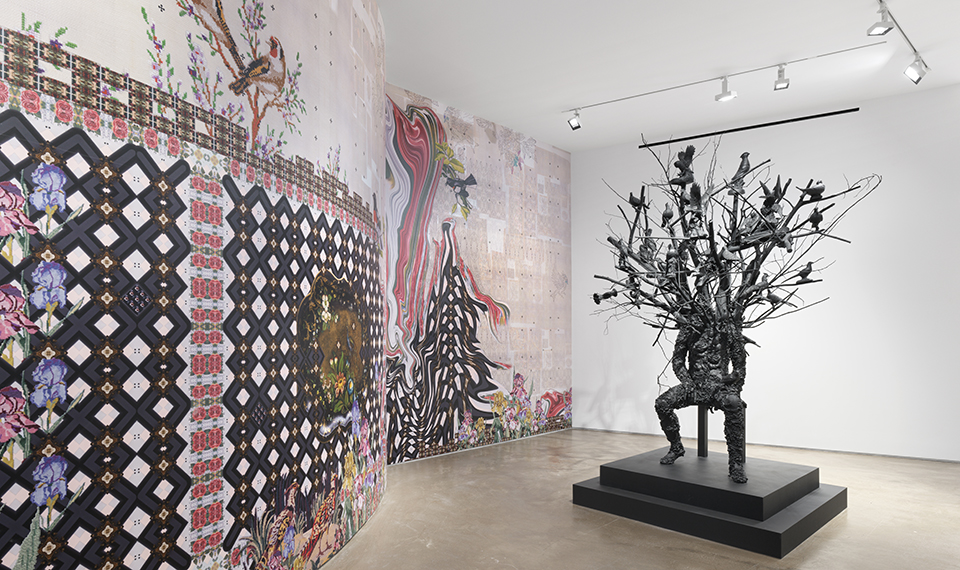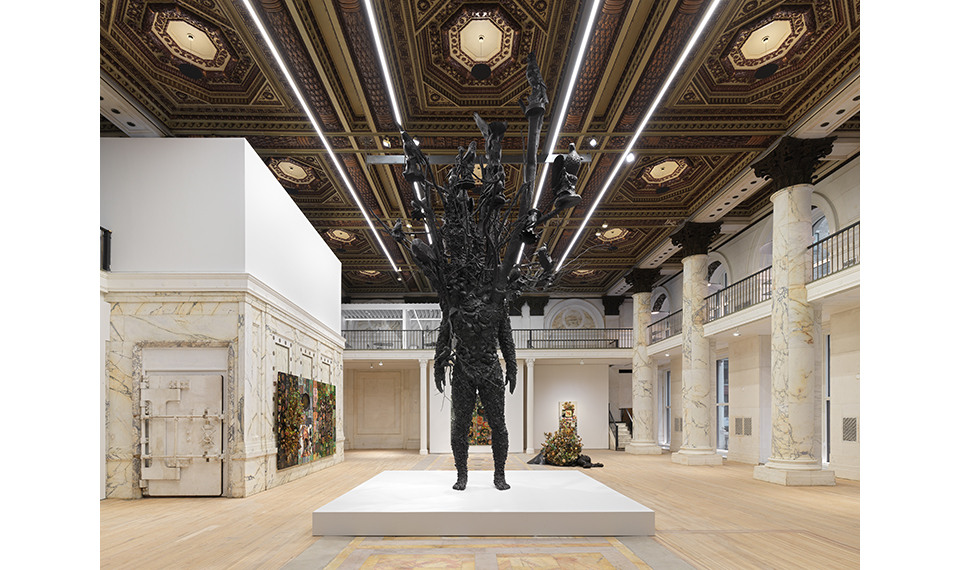Nick Cave at Jack Shainman Gallery
Richard Boch talks to gallerist Jack Shainman about his expansive new Tribeca flagship and the importance of Nick Cave’s work.
Change is a never-ending part of life. Occasionally the change is barely noticeable while other times we see it happen right before our eyes. The city, the neighborhood, the places we live and the places we frequent—they all change. I was born in Brooklyn, once considered a faraway land inhabited by the bridge and tunnel people but today it’s a vibrant and respected borough of New York City. I’ve watched this city change over the course of my life and I’ve experienced that change first-hand having moved to Bleecker Street in 1976 before living in TriBeCa for nearly thirty years. I worked in those neighborhoods and I discovered who I was while living there. One of those discoveries being that change is inevitable.
The landmark Clocktower Building at 46 Lafayette Street was completed in 1898 during the final years of New York’s Gilded Age. Stanford White, the accomplished but notoriously controversial architect was a key player in its design and construction. He was murdered eight years later—his death, the result of a twisted love triangle gone bad—as they often do. Like everything else, The Clocktower experienced change over the last one-hundred-twenty-plus years, though its history, with the exception of several bursts of artistic energy, notably the legendary Clocktower Gallery and its renowned and innovative director Alana Heiss, the building itself remained institutionally boring—until now. That’s when gallerist Jack Shainman got involved, and after several years restoring the twenty-thousand-square-foot first floor to next-level perfection he chose the brilliant multi-media artist Nick Cave and his latest work, Amalgams and Graphts to inaugurate what would be Shainman’s New York flagship gallery.
Reimagining a massive space in the block-long American Renaissance Beaux-Arts building, with the imposing stature of The Clocktower, requires both vision and courage—not to mention a team with the ability to make it happen. It’s the latest version, or maybe a thematic variation of what Jack Shainman was able to see and do when he began looking at The School in upstate Kinderhook, New York, a thirty-thousand-square-foot red brick school building originally completed in 1929. A vast survey of the work of Nick Cave inaugurated The School in 2014, while the collaborative paintings of Andy Warhol and Jean-Michel Basquiat, including individual work by each artist, followed several years later. Filling out The School’s exhibition schedule of the last decade were surveys of work by El Anatsui and Michael Snow among others.
What lies ahead at Shainman’s 46 Lafayette Street, is sure to be visionary from both the perspective of the gallery and the roster of artists they choose to present. The relationship between Nick Cave and Jack Shainman, as well as the 46 Lafayette Street space itself, is a fascinating three-way connection that becomes even more intriguing when we’re given the chance to witness it all first-hand. I walked over to Lafayette Street from Soho Grand Hotel and was overwhelmed stepping into the newly restored gallery for the first time. The scale of both the work and the space as well as the dynamic of how it comes together is both purposeful and beautiful, and in the way of all great art, offers a spiritually unique dialogue that becomes the Nick Cave, Jack Shainman, 46 Lafayette Street Experience.
I recently had the opportunity to ask Jack Shainman a few questions about his vision as a gallerist and curator, the importance of Nick Cave’s work and how it all came together.

Nick Cave A·mal·gam, 2021 bronze, 122 x 94 x 85 inches
Richard Boch: Hello Jack, the new space is incredible and despite having lived and worked downtown from 1976 through 2005, I walked over here not quite knowing what to expect from 46 Lafayette Street. The Clocktower Building as it’s called is a landmark and has certainly gone through many changes over the last century or more, yet no one seemed to know what to do with its potential—that is until you came along. What you’ve done here is a bit contrary to both the white walls of Chelsea and the rough edges of the smaller gallery spaces that are repopulating the streets of TriBeCa. You took on the more is more Beaux-Arts aesthetic and brought it back to life. How did that all come about and did you fully realize what you were getting into?
Jack Shainman: After spending nearly 10 years looking for a new location for the gallery, we happened upon this space. It was so outside of what we were originally looking for, but it had an amazing soul.
The first time we saw it, it was totally disheveled and falling apart, but there was something so magical about it. I’m always saying the space seduced us and in a sense, it really did—it’s over 20,000 square feet! There are only one or two walls, so we’ve had to figure out how to navigate and install artwork, but what’s interesting is that it’s provided us with new creative challenges and ways to install work, juxtaposed against the historic architectural elements and details.
View this post on Instagram
RB: Correct me if I’m wrong but I believe the artist Nick Cave first showed at your West 20th Street space back in 2006. I’ve seen his work numerous times but most memorably at your space, The School in Kinderhook for the 2014 inaugural exhibition. You had Nick open the space with an extraordinary exhibition of his work including a live performance on the lawn. Nearly eleven years later we have a variation on the theme of restoring, rebranding and offering new life to another unique space. Did you have Nick Cave in mind for the opening of 46 Lafayette Street from the outset? Could it have been anyone else?
JS: I always thought of Nick Cave—as well as other artists on our roster who like to work on a large scale, early on in this project. More than three years ago now, Nick and his longtime partner Bob Faust came to see the space and it was almost like we all knew immediately that it was Nick who would have the inaugural exhibition, potentially showcasing a large standing bronze figure. He’s always up for a big challenge and after his Guggenheim show, this seems like the perfect moment to collaborate on a project of this scale. It’s been a few years since then, which gave him time to really think and develop this new work.
RB: How does the vision of Nick Cave inform your vision as a gallerist? What have you learned from him?
JS: I’ve known Nick for quite a long time, although it doesn’t feel that way—and we have a very deep friendship. I respect him and his vision immensely. He never compromises and always accomplishes what he wants to do and what he’s set out to do, which I admire. It’s been really exciting working with Nick over the last 18 or so years, watching his work grow and seeing the evolution of his exhibitions. It’s probably one of the most gratifying things as a gallerist. What I’ve learned from Nick is always to follow your dream and never compromise on your vision. Anything is possible!
RB: Thanks Jack—it’s a beautiful show and I’m looking forward to seeing what’s next for 46 Lafayette Street.

Nick Cave Amalgam (Origin), 2024 bronze, 309 5/8 x 201 x 227 inches
***
Nick Cave Amalgams and Graphts
Jack Shainman Gallery 46 Lafayette Street NYC
10am to 6pm Tuesday to Saturday through March 29, 2025
INTERVIEW Richard Boch
PHOTOGRAPHY ©Nick Cave Courtesy of the artist and Jack Shainman Gallery.
Photos Dan Bradica Studio.
Richard Boch writes GrandLife’s New York Stories column and is the author of The Mudd Club, a memoir recounting his time as doorman at the legendary New York nightspot, which doubled as a clubhouse for the likes of Jean-Michel Basquiat, Keith Haring, Debbie Harry and Talking Heads among others. To hear about Richard’s favorite New York spots for art, books, drinks, and more, read his Locals interview—here.